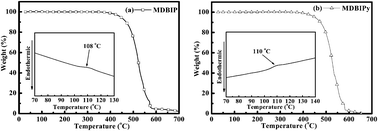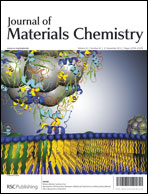Two novel simple electron-transport (ET) type host materials, 2,6-bis(3-(1-phenyl-1H-benzo[d]imidazol-2-yl)phenyl)benzene (MDBIP) and 2,6-bis(3-(1-phenyl-1H-benzo[d]imidazol-2-yl)phenyl)pyridine (MDBIPy) have been designed and synthesized. The two compounds exhibit high decomposition temperatures (Td: 444 °C for MDBIP and 450 °C for MDBIPy) and a stable amorphous glassy state (Tg: 108 °C for MDBIP and 110 °C for MDBIPy). In the typical device ITO/MoO3 (10 nm)/4,4′-bis[N-(1-naphthyl)-N-phenylamino]biphenyl (NPB, 80 nm)/TCTA (5 nm)/Host: Ir(ppy)3 (9 wt%, 20 nm)/TmPyPB (40 nm)/LiF (1 nm)/Al (100 nm), when MDBIPy was used as host material, the device B showed a maximum efficiency of 21.1%, 75.8 cd A−1 and 83.6 lm W−1. When MDBIPy was utilized as both the electron transporting and host layer, the unilateral homogeneous device C exhibited a maximum efficiency of 20.6%, 74.2 cd A−1 and 71.8 lm W−1. More interestingly, device C showed low efficiency roll-off relative to device B. When the brightness of the device is over 1000 cd m−2, the current efficiency of device C is higher than device B. At a brightness of 5000 cd m−2, the current efficiency of device C is only roll off 5.6%. These results demonstrate that utilizing electron-transport type host materials to fabricate unilateral homogeneous PhOLEDs is a promising way to simplify the device configuration and optimize the performance of OLED devices.

You have access to this article
 Please wait while we load your content...
Something went wrong. Try again?
Please wait while we load your content...
Something went wrong. Try again?


 Please wait while we load your content...
Please wait while we load your content...